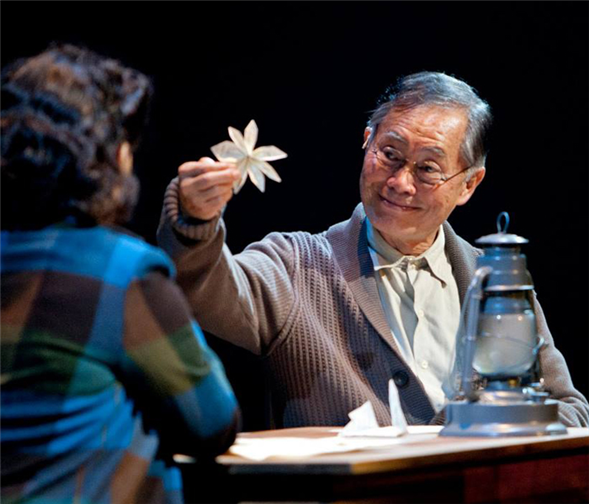Translate Page

Dance tells a complex story in the Broadway musical Allegiance
---
Inspired by actor George Takei's life, Allegiance is distinguished not only by the caché of its famous source, but also the gravitas of its subject matter: The musical tells the tale of Takei's experience as a Japanese American during WWII, including the horrible reality of internment camps and his family's fate during the political whirlpool driven by war.
But along with this serious underpinning, the show, which is now on Broadway at the Longacre Theatre, also features familiar tropes of Americana -- baseball, community, perseverance, and the red, white, and blue. These elements are just as essential in telling Takei's complex story.
Hoping to capture both the darkness and the light in his past, the creative team has been fixated on mastering the tonal balance, and dance, as created by choreographer Andrew Palermo, has served as a powerful tool in doing so.
"It's a story of gaman, the Japanese word that means to persevere," Palermo says. "This family got through being interned with their heads held high, and ultimately, it's a story about finding inspiration in dark places. So, this show has huge high moments: a big swing number, a baseball number, and so on. We have our eye on a constant tug of war between the weighty story and having the audience leave the theatre feeling uplifted. It's both, and the dance serves as an escape in many places."
On an invitation from director Stafford Arima, a frequent collaborator, Palermo joined the musical in 2012, when it received its first full production at San Diego's Old Globe (the photo above is from that production). Taking over for choreographer Christopher Gattelli, who shepherded the piece through several development workshops, Palermo dug into research about the time period and the camps. He also aimed to add more movement to the production, and the amount of dance has increased with each iteration, from the California run to investor showings to Broadway.
Many drafts later ("I'd say this is version D or even E!" Palermo says), Allegiance is bursting with diverse movement that expresses the full range of Takei's experience. There are huge numbers that recall musical theatre classics, but there are also gestural, angular, modern elements that portray the camp inmates and the figurative storminess of the time.
{Image1}
"I'm not a purist," says Palermo of the wide-ranging styles of his choreography. "If something is set in an era, I'll do what I have to do to be authentic, but I want to make sure it's my voice and appeals to a current audience. So when there were times to push the boundaries and do something a little more interpretive and a little less 40s, I immediately started to infuse my own voice in those places. There's a number in the show called 'Do Not Fight the Storm,' about what happened right after Pearl Harbor: the terror and confusion as Japanese-Americans started being sent to the camps. There, I was able to infuse interpretive, stylized, and heightened movement because it's reflecting characters' inner battles as much as the physical situation."
To depict the dust storms that arise in the California heat – and also reflect the emotional chaos of the times – Palermo created an "add-on piece," a modern dance concept that builds gestures on each other, one at a time, always returning to the first movements before adding another.
"This is an interpretation of the struggle and suffering in an actual and figurative dust storm," he says. "In gesture, how would it look if you were in a wicked dust storm? How would your hand swipe across face? Would you stumble? So we created simple movement anyone could do and added on gesture by gesture, which I haven't seen on Broadway. When Stafford saw it and liked it, we decided to weave it throughout the show. It's a motif that's recognizable but not overt, just like the movement itself."
Traditional Japanese dance, which had been absent in earlier versions, serves as another notable addition to the Broadway run. "Each number has a different temperature, and the authentic, traditional Japanese movement is more insular," says Palermo. "We were able to cast [ensemble members] Rumi Oriyama and Janelle Dote, who are both well-versed in the art form. It's fluid, specific, and small, focused on turning the chin at a certain angle, and so on. Rumi does a traditional Japanese fan dance, and it's its own language."
He continues, "Now the show has the full spectrum of colors. Going in, I was worried about the idea of including so many styles: Will this feel like a kitchen sink? But it seems the audiences can see the throughline. I look for movement that comes from the core. It doesn't start with your hands; it starts with your gut, the emotional and physical center. And this show resides in that same place. "
---
TDF MEMBERS: At press time, TDF is offering discounted tickets to Allegiance. Click here to see all our available shows.
Lauren Kay regularly writes about dance for TDF Stages.
Photo of George Takei, taken from the Old Globe production, by Henry DiRocco. Middle photo by Matthew Murphy.